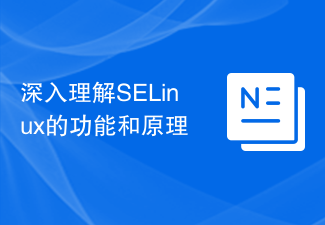Found a total of 10000 related content

Understand the different working modes of SELinux
Article Introduction:SELinux is a security-enhanced Linux. Its full name is Security-EnhancedLinux, which is a security module of the Linux kernel. It can provide mandatory access control function, through which the security of the system can be better protected. SELinux can effectively prevent malicious programs from abusing system resources by controlling the permissions of processes to access resources. In SELinux, there are three working modes: Enforcing, Permissiv
2024-02-26
comment 0
862

Explore how SELinux works
Article Introduction:In today's Internet era, network security issues have become increasingly prominent. In order to protect the system from malicious attacks and unauthorized access, the operating system has higher requirements for security mechanisms. SELinux (Security-EnhancedLinux), as a security module of the Linux kernel, provides powerful security policies and access control mechanisms, providing additional security for the system. 1. The working mode of SELinux. SELinux adopts the mandatory access control (MAC) mechanism, which is different from the traditional
2024-02-26
comment 0
913

A Deep Dive into SELinux: A Comprehensive Analysis
Article Introduction:What is SELinux? This article explains in detail that SELinux (Security-EnhancedLinux) is a security-enhanced Linux system security extension module designed to improve the security of the Linux operating system. By implementing a Mandatory Access Control (MAC) mechanism, SELinux can limit program access and protect the system from malware and attackers. In this article, we will explain in detail how SELinux works and provide specific code examples to
2024-02-26
comment 0
1215

Study the three policy types of SELinux
Article Introduction:SELinux (Security-EnhancedLinux) is a security subsystem in the Linux system. It provides an access control security mechanism and restricts the behavior of programs and users through mandatory access control (MAC) to improve system security. The core of SELinux is a policy-based mechanism, which can control different access permissions through different types of policies. In SELinux, there are three main policy types, including: role-based access control (RBAC), basic
2024-02-26
comment 0
1016

In-depth exploration of the three policy classifications of SELinux
Article Introduction:SELinux is a mandatory access control security technology used to enhance the security of Linux operating systems. In SELinux, policies are divided into three main categories: TargetedPolicy, Multiple Policies (MLS/MCSPolicy), and CustomPolicy. These three policy classifications play an important role in the security mechanism of SELinux. This article will introduce these three policies in detail with specific code examples.
2024-02-26
comment 0
1038

Analyzing SELinux: Principles and Practice
Article Introduction:In recent years, with the rapid development of information technology, network security issues have become increasingly prominent. In order to improve the security of the system, various security mechanisms have emerged. Among them, SELinux (Security-EnhancedLinux), as a security extension module, is widely used in Linux systems, providing a higher level of security policy implementation for the system. 1. Functional principles of SELinux The core idea of SELinux is to limit the permissions and behavior of programs through authorized access. Traditional Linu
2024-02-26
comment 0
866

In-depth analysis: the concept and role of SELinux
Article Introduction:SELinux is a security-enhanced Linux system, its full name is Security-EnhancedLinux, which aims to improve the security of the Linux operating system. SELinux is designed to provide more granular access control on top of traditional Linux permission management to protect the security of system resources and data. This article will delve into the definition and functions of SELinux and provide specific code examples to help readers better understand and use SELinux. 1. S
2024-02-24
comment 0
1036

In-depth understanding of the functions and principles of SELinux
Article Introduction:SELinux is a Mandatory Access Control (MAC) security mechanism used to protect Linux operating systems and applications from malicious attacks and unauthorized access. This article will deeply explore the functions and principles of SELinux, and provide specific code examples to help readers better understand and apply this security tool. 1. The role of SELinux SELinux is a security mechanism implemented at the kernel level. Its purpose is to strengthen the security of the Linux system and provide more fine-grained access control. Compared to passing
2024-02-24
comment 0
1023

An in-depth analysis of the three policy types of SELinux
Article Introduction:Detailed explanation of the three policy types of SELinux and code examples SELinux (Security-EnhancedLinux) is a security subsystem that implements mandatory access control on the Linux operating system. It ensures the security of the system by defining mandatory access rules for each operation. In SELinux, there are three main policy types: Enforcing, Permissive, and Disabled. This article will introduce these three in detail
2024-02-26
comment 0
1056

Analyze the working mode of SELinux
Article Introduction:Title: SELinux working mode analysis and code examples In modern computer systems, security has always been a crucial aspect. In order to protect servers and applications from malicious attacks, many operating systems provide a security mechanism called SELinux (Security-EnhancedLinux). SELinux is a mandatory access control (MAC) system that can implement fine-grained access control to system resources. This article will analyze the working mode of SELinux
2024-02-26
comment 0
795

Study the three policy types of SELinux
Article Introduction:SELinux is a security-enhanced Linux operating system security module. Its core is to improve system security through mandatory access control. In SELinux, policy types are an important part of defining security policies. According to different needs and scenarios, SELinux provides three different policy types, namely MLS (Multi-LevelSecurity), TE (TypeEnforcement), RBAC (Role- BasedAcc
2024-02-26
comment 0
927

Familiar with the three working modes of SELinux
Article Introduction:SELinux (Security-EnhancedLinux) is a security module that implements Mandatory Access Control (MAC) in Linux systems. It enforces security policies by applying labels to system objects (files, processes, etc.) for more fine-grained access control. SELinux has three working modes: Enforcing, Permissive and Disabled. This article will introduce these three modes in detail and provide specific code examples. 1
2024-02-26
comment 0
1069

Master the SELinux Policy Categories
Article Introduction:SELinux is a MandatoryAccessControl (MAC)-based security mechanism used to restrict program and user access to system resources. In SELinux, policy types are one of the important concepts used to define and control access rights to objects. This article will introduce the policy types in SELinux and use specific code examples to help readers better understand. Overview of SELinux policy types In SELinux, each object (file, process, etc.) has an associated
2024-02-26
comment 0
574

An in-depth discussion of the three working modes of SELinux
Article Introduction:Detailed explanation of the three working modes of SELinux SELinux is a mandatory access control (MAC) technology designed to enhance the security of Linux systems. It uses tags to mark resources in the system (such as files, processes, and ports) and defines policies to control process access to these resources. In SELinux, there are three main working modes: forced mode, elastic mode and harmless mode. This article will introduce these three working modes in detail and provide specific code examples. Enforcing mode
2024-02-26
comment 0
702

What are the security considerations for deploying PHP applications in the cloud?
Article Introduction:The main security considerations for deploying PHP applications in the cloud include: Network security: Use SSL/TLS to encrypt traffic, enable firewalls, and restrict access from external IP addresses. Server configuration: Update patches in a timely manner, disable unnecessary services, and optimize PHP configuration. Code safety: validate input, use validated libraries to handle input, enable error reporting. Database security: Use strong passwords, restrict access, and back up regularly. File system security: restrict access permissions, use chroot to limit access, monitor file system activity.
2024-05-06
comment 0
481

How to use php functions to optimize cross-domain requests and security restrictions?
Article Introduction:How to use PHP functions to optimize cross-domain requests and security restrictions? In web development, cross-domain requests and security restrictions are common problems. Cross-domain request refers to a page under one domain name accessing resources under another domain name. Due to browser security policies, ordinary cross-domain requests are prohibited. Security restrictions refer to measures to prevent malicious attacks and protect user privacy. PHP provides some functions and methods to optimize these problems. This article will introduce how to use these functions to solve the problems of cross-domain requests and security restrictions. For cross-domain request issues
2023-10-05
comment 0
957

Basic principles of Linux permission control
Article Introduction:This article mainly introduces the basic principles of permission control in Linux systems. Security Model In the Linux system, all our operations are essentially processes accessing files. To access files, we need to obtain the corresponding access permissions first, and the access permissions are obtained through the security model in the Linux system. Regarding the security model in the Linux system, we need to know the following two points: The original security model on the Linux system is called DAC, whose full name is DiscretionaryAccessControl, which translates to autonomous access control. Later, a new security model was added and designed called MAC, whose full name is MandatoryAccessControl, which is translated as mandatory access control.
2023-12-31
comment 0
1295

How does Java security mechanism work with other security technologies?
Article Introduction:Java's powerful security mechanisms work in conjunction with other security technologies to protect applications: java.security.Manager controls permissions, such as access to the file system; code signing verifies code authenticity; and access control restricts access to resources. In practice, sensitive files can be protected by coordinating these technologies, such as restricting application access to the file system, adding code to check access permissions, and using digital certificates to sign applications.
2024-04-18
comment 0
767

How to use Linux server to strengthen access control of web interface?
Article Introduction:How to use Linux server to strengthen access control of web interface? In today's Internet era, the security of Web interfaces has attracted much attention. In order to strengthen the access control of the web interface, we can achieve higher security by using a Linux server. This article will introduce some methods and techniques to help you strengthen access control of web interfaces. As a first step, we first need to ensure that the server's operating system is up to date and has been updated to the latest security patches. This can be managed through regular system updates and the use of appropriate software packages
2023-09-10
comment 0
1041

Why can't mysql only write one row when creating a table?
Article Introduction:The reasons why MySQL can only write one row when creating a table include: 1. max_allowed_packet variable limitation; 2. Safe mode; 3. JDBC driver limitation; 4. ORM framework limitation; 5. innodb_log_file_size variable limitation. You can resolve this issue by increasing the value of the max_allowed_packet variable, disabling safe mode, using a newer JDBC driver, using simpler query syntax, or increasing the value of the innodb_log_file_size variable.
2024-04-22
comment 0
684



















